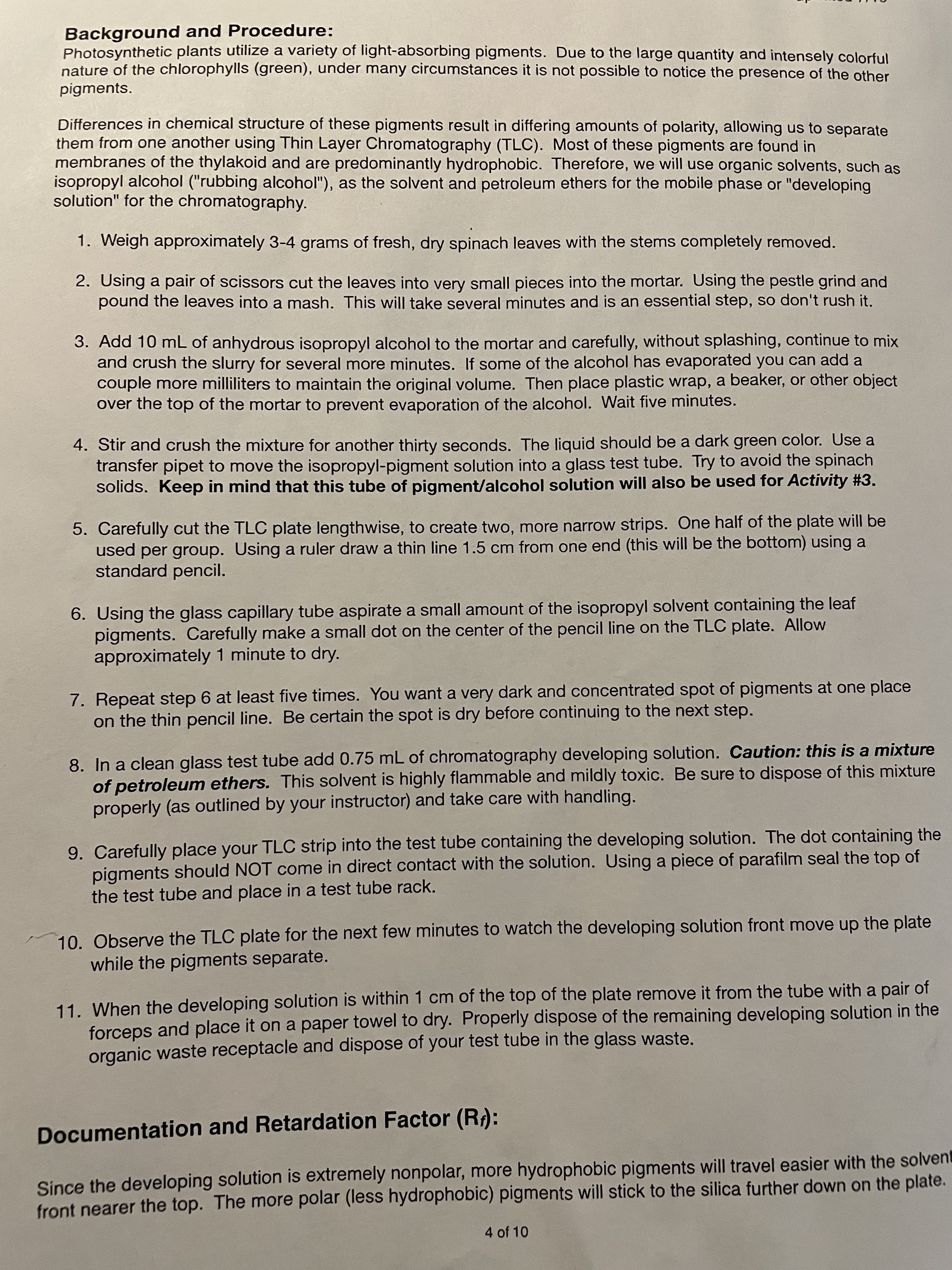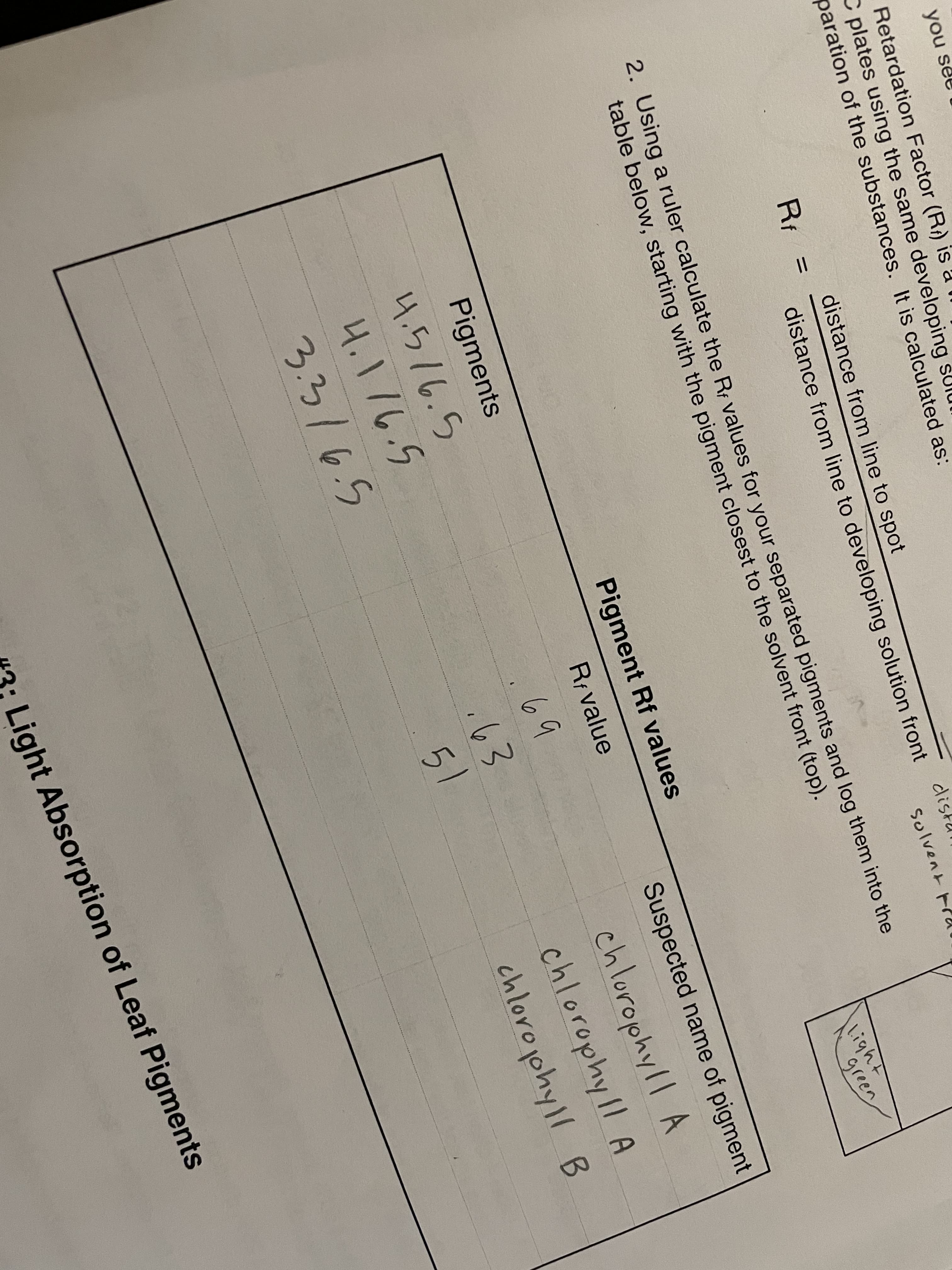Biology: The Dynamic Science (MindTap Course List)
4th Edition
ISBN:9781305389892
Author:Peter J. Russell, Paul E. Hertz, Beverly McMillan
Publisher:Peter J. Russell, Paul E. Hertz, Beverly McMillan
Chapter8: Photosynthesis
Section: Chapter Questions
Problem 13TYK: Discuss Concepts Like other accessory pigments, the carotenoids extend the range of wavelengths...
Related questions
Question
Comparing the chlorophyll a and b why did chlorophyll a travel the farthest on the tlc plate ?

Transcribed Image Text:Background and Procedure:
Photosynthetic plants utilize a variety of light-absorbing pigments. Due to the large quantity and intensely colorful
nature of the chlorophylls (green), under many circumstances it is not possible to notice the presence of the other
pigments.
Differences in chemical structure of these pigments result in differing amounts of polarity, allowing us to separate
them from one another using Thin Layer Chromatography (TLC). Most of these pigments are found in
membranes of the thylakoid and are predominantly hydrophobic. Therefore, we will use organic solvents, such as
isopropyl alcohol ("rubbing alcohol"), as the solvent and petroleum ethers for the mobile phase or "developing
solution" for the chromatography.
1. Weigh approximately 3-4 grams of fresh, dry spinach leaves with the stems completely removed.
2. Using a pair of scissors cut the leaves into very small pieces into the mortar. Using the pestle grind and
pound the leaves into a mash. This will take several minutes and is an essential step, so don't rush it.
3. Add 10 mL of anhydrous isopropyl alcohol to the mortar and carefully, without splashing, continue to mix
and crush the slurry for several more minutes. If some of the alcohol has evaporated you can add a
couple more milliliters to maintain the original volume. Then place plastic wrap, a beaker, or other object
over the top of the mortar to prevent evaporation of the alcohol. Wait five minutes.
4. Stir and crush the mixture for another thirty seconds. The liquid should be a dark green color. Use a
transfer pipet to move the isopropyl-pigment solution into a glass test tube. Try to avoid the spinach
solids. Keep in mind that this tube of pigment/alcohol solution will also be used for Activity #3.
5. Carefully cut the TLC plate lengthwise, to create two, more narrow strips. One half of the plate will be
used per group. Using a ruler draw a thin line 1.5 cm from one end (this will be the bottom) using a
standard pencil.
6. Using the glass capillary tube aspirate a small amount of the isopropyl solvent containing the leaf
pigments. Carefully make a small dot on the center of the pencil line on the TLC plate. Allow
approximately 1 minute to dry.
7. Repeat step 6 at least five times. You want a very dark and concentrated spot of pigments at one place
on the thin pencil line. Be certain the spot is dry before continuing to the next step.
8. In a clean glass test tube add 0.75 mL of chromatography developing solution. Caution: this is a mixture
of petroleum ethers. This solvent is highly flammable and mildly toxic. Be sure to dispose of this mixture
properly (as outlined by your instructor) and take care with handling.
9. Carefully place your TLC strip into the test tube containing the developing solution. The dot containing the
of
pigments should NOT come in direct contact with the solution. Using a piece of parafilm seal the top
the test tube and place in a test tube rack.
10. Observe the TLC plate for the next few minutes to watch the developing solution front move up the plate
while the pigments separate.
11. When the developing solution is within 1 cm of the top of the plate remove it from the tube with a pair of
forceps and place it on a paper towel to dry. Properly dispose of the remaining developing solution in the
organic waste receptacle and dispose of your test tube in the glass waste.
Documentation and Retardation Factor (R):
Since the developing solution is extremely nonpolar, more hydrophobic pigments will travel easier with the solvent
front nearer the top. The more polar (less hydrophobic) pigments will stick to the silica further down on the plate.
4 of 10

Transcribed Image Text:you s
Retardation Factor (R)
C plates using the same developing
paration of the substances. It is calculated as:
Rf =
distance from line to spot
%3D
distance from line to developing solution front
dis
Solvent t
2. Using a ruler calculate the Rf values for your separated pigments and log them into the
table below, starting with the pigment closest to the solvent front (top).
Light
green
Pigment Rf values
Pigments
R/ value
Suspected name of pigment
4.516.5
69
chlorophyll A
4.176.5
63
51
chlorophy |l A
chlorojohyll B
3.3/6.5
3; Light Absorption of Leaf Pigments
Expert Solution
This question has been solved!
Explore an expertly crafted, step-by-step solution for a thorough understanding of key concepts.
This is a popular solution!
Trending now
This is a popular solution!
Step by step
Solved in 2 steps

Knowledge Booster
Learn more about
Need a deep-dive on the concept behind this application? Look no further. Learn more about this topic, biology and related others by exploring similar questions and additional content below.Recommended textbooks for you

Biology: The Dynamic Science (MindTap Course List)
Biology
ISBN:
9781305389892
Author:
Peter J. Russell, Paul E. Hertz, Beverly McMillan
Publisher:
Cengage Learning


Biology (MindTap Course List)
Biology
ISBN:
9781337392938
Author:
Eldra Solomon, Charles Martin, Diana W. Martin, Linda R. Berg
Publisher:
Cengage Learning

Biology: The Dynamic Science (MindTap Course List)
Biology
ISBN:
9781305389892
Author:
Peter J. Russell, Paul E. Hertz, Beverly McMillan
Publisher:
Cengage Learning


Biology (MindTap Course List)
Biology
ISBN:
9781337392938
Author:
Eldra Solomon, Charles Martin, Diana W. Martin, Linda R. Berg
Publisher:
Cengage Learning

Biology 2e
Biology
ISBN:
9781947172517
Author:
Matthew Douglas, Jung Choi, Mary Ann Clark
Publisher:
OpenStax

Principles Of Radiographic Imaging: An Art And A …
Health & Nutrition
ISBN:
9781337711067
Author:
Richard R. Carlton, Arlene M. Adler, Vesna Balac
Publisher:
Cengage Learning